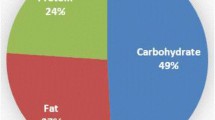Summary
Feeding pattern was studied in 13 long distance runners, eight cyclists and eight sedentary men. The timing of the food and fluid intakes, the kind and the amount of food and fluids taken, the body weight (BW), and the exercise schedules were recorded on 3 or 4 successive days under ad libitum conditions of feeding and drinking. The subjects remained in energy and water balance, since the BW measured in the morning during the observation periods did not change significantly. The total caloric intake was 13 876 kJ per day in the runners and 26 282 kJ per day in the cyclists, exceeding the estimated basic metabolic rate by 103% and 250% respectively. The total water intakes were 33 and 36 ml·kg−1·24 h−1. The athletes consistently showed a nibbling pattern, characterized by frequent eating and drinking (average 8–10 per day). In the runners 63% of eating and drinking were synchronized, in the cyclists only 49% (p<0.01). In both groups drinking occurred most frequently in the morning, at noontime and in the evening. After 8 p.m. 45% of the total daily fluid intake occurred. In all likelihood the fluid intake followed an underlying circadian rhythm. The total intake frequency was determined by the total caloric needs.
Similar content being viewed by others
References
Adolph EF (1969) Heat exchanges, sweat formation, and water turnover. In: Adolph EF and Associates (eds) Physiology of man in the desert. Hafner, New York London, pp 33–43
Adolph EF and Associates (1969) Physiology of man in the desert. Hafner, New York London, p 65
Andersson B (1978) Regulation of water intake. Physiol Rev 58: 582–603
Aschoff J, Kramer K (1971) Energiestoffwechsel. In: Gauer OH, Kramer K, Jung R (Hrsg) Physiologie des Menschen. Energiehaushalt und Temperaturregulation, Bd 2, Urban & Schwarzenberg, München Berlin Wien, pp 1–42
åstrand PO, Rodahl K (1970) Textbook of work physiology. McGraw-Hill, New York St. Louis San Francisco London Sydney Toronto Mexico Panama, pp 455–488
Baile CA, Forbes JM (1974) Control of feed intake and regulation of energy balance in ruminants. Physiol Rev 54: 160–214
Baile CA, Zinn WM, Mayer J (1970) Effects of lactate and other metabolites on food intake of monkeys. Am J Physiol 219: 1606–1613
Brown AH (1969) Fluid intakes in the desert. In: Adolph EF and Associates (eds) Physiology of man in the desert. Hafner, New York London, pp 110–114
Cohn C, Joseph D (1960) Role of rate of ingestion of diet on regulation of intermediary metabolism (“meal eating” versus “nibbling”). Metabolism 9: 492–500
Cohn C, Joseph D (1960) Effects on metabolism produced by the rate of ingestion of the diet. “Meal eating” versus “nibbling”. Am J Clin Nutr 8: 682–690
Collier G (1969) Body weight loss as a measure of motivation in hunger and thirst. Ann NY Acad Sci 157: 594–609
Costill DL, Kammer WF, Fisher A (1970) Fluid ingestion during distance running. Arch Environ Health 21: 520–525
Fitzsimons JT (1957) Normal drinking in rats. J Physiol 138: 39
Fitzsimons JT (1972) Thirst. Physiol Rev 52: 468–561
JR Geigy AG (1975) Pharmazeutische Abteilung: Documenta Geigy, Wissenschaftliche Tabellen
Magnen J le (1969) Peripheral and systemic actions of food in the caloric regulation of intake. Ann NY Acad Sci 157: 1126–1157
Mayer J, Bullen B (1960) Nutrition and athletic performance. Physiol Rev 40: 369–397
Mayer J, Thomas DW (1967) Regulation of food intake and obesity. Science 156: 328–337
Novin D, Wyrwicka W, Bray GA (1976) Hunger, basic mechanisms and clinical implications. Raven Press, New York
Oatley K (1971) Dissociation of the circadian drinking pattern from eating. Nature 229: 494–496
Pudel VE (1976) Experimental feeding in man. In: Silverstone T, Bernhard S (eds) Appetite and food intake. Dahlem Konferenzen. Abakon, Berlin, pp 245–264
Saltin B (1964) Aerobic work capacity and circulation at exercise in man: With special reference to the effect of prolonged exercise and/or heat exposure. Acta Physiol Scand [Suppl 230] 62: 1–52
Silverstone T, Bernhard S (1976) Appetite and food intake (Report of the Dahlem Workshop). Dahlem Konferenzen. Abakon, Berlin
Stevenson JAF, Box BM, Feleki V, Beaton JR (1966) Bouts of exercise and food intake in the rat. J Appl Physiol 21: 118–122
Tuttle WW, Wilson M, Daum K (1949) Effect of altered breakfast habits on physiologic response. J Appl Physiol 1: 545–559
Author information
Authors and Affiliations
Additional information
Supported by the Bundesinstitut für Sportwissenschaften, Köln
Rights and permissions
About this article
Cite this article
Kirsch, K.A., von Ameln, H. Feeding patterns of endurance athletes. Europ. J. Appl. Physiol. 47, 197–208 (1981). https://doi.org/10.1007/BF00421672
Accepted:
Issue Date:
DOI: https://doi.org/10.1007/BF00421672




